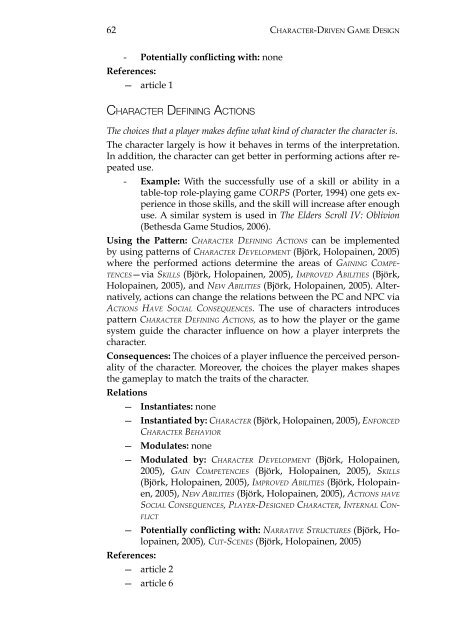Character Driven Game Design
Character Driven Game Design
Character Driven Game Design
You also want an ePaper? Increase the reach of your titles
YUMPU automatically turns print PDFs into web optimized ePapers that Google loves.
62<br />
<strong>Character</strong>-<strong>Driven</strong> <strong>Game</strong> <strong>Design</strong><br />
- Potentially conflicting with: none<br />
References:<br />
——<br />
article 1<br />
<strong>Character</strong> Defining Actions<br />
The choices that a player makes define what kind of character the character is.<br />
The character largely is how it behaves in terms of the interpretation.<br />
In addition, the character can get better in performing actions after repeated<br />
use.<br />
- Example: With the successfully use of a skill or ability in a<br />
table-top role-playing game CORPS (Porter, 1994) one gets experience<br />
in those skills, and the skill will increase after enough<br />
use. A similar system is used in The Elders Scroll IV: Oblivion<br />
(Bethesda <strong>Game</strong> Studios, 2006).<br />
Using the Pattern: <strong>Character</strong> Defining Actions can be implemented<br />
by using patterns of <strong>Character</strong> Development (Björk, Holopainen, 2005)<br />
where the performed actions determine the areas of Gaining Competences—via<br />
Skills (Björk, Holopainen, 2005), Improved Abilities (Björk,<br />
Holopainen, 2005), and New Abilities (Björk, Holopainen, 2005). Alternatively,<br />
actions can change the relations between the PC and NPC via<br />
Actions Have Social Consequences. The use of characters introduces<br />
pattern <strong>Character</strong> Defining Actions, as to how the player or the game<br />
system guide the character influence on how a player interprets the<br />
character.<br />
Consequences: The choices of a player influence the perceived personality<br />
of the character. Moreover, the choices the player makes shapes<br />
the gameplay to match the traits of the character.<br />
Relations<br />
——<br />
Instantiates: none<br />
——<br />
Instantiated by: <strong>Character</strong> (Björk, Holopainen, 2005), Enforced<br />
<strong>Character</strong> Behavior<br />
——<br />
Modulates: none<br />
——<br />
Modulated by: <strong>Character</strong> Development (Björk, Holopainen,<br />
2005), Gain Competencies (Björk, Holopainen, 2005), Skills<br />
(Björk, Holopainen, 2005), Improved Abilities (Björk, Holopainen,<br />
2005), New Abilities (Björk, Holopainen, 2005), Actions have<br />
Social Consequences, Player-<strong>Design</strong>ed <strong>Character</strong>, Internal Conflict<br />
——<br />
Potentially conflicting with: Narrative Structures (Björk, Holopainen,<br />
2005), Cut-Scenes (Björk, Holopainen, 2005)<br />
References:<br />
——<br />
article 2<br />
——<br />
article 6
















